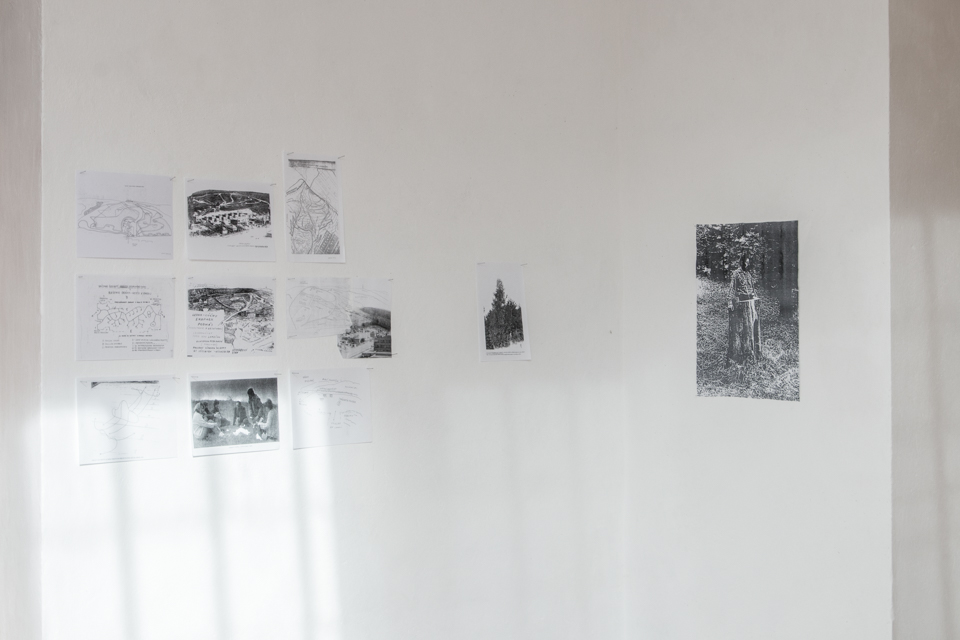ZOO Bratislava
Peter Bartoš
20.10. – 20.11.16
Although Slovak neo avant-garde artist Peter Bartoš (1938) is a radical figure on the Slovak art scene, his work has still not been fully documented. Since he only selectively shares information about his work, Bartoš is difficult to access. His background as a painter, though, has always been an important impetus for his work. And, whilst strongly bound to ontological meanings, at the same time his works are based on a conceptual analysis of the medium of painting and its innate structure. Bartoš wanted to extend the possibilities of painting and create work that would be absorbed by nature and further permanently transformed or recycled within it. He has performed several processual experiments with ephemeral natural materials, such as snow. His documentation includes photo series paintings, re-drawings, photocopies (cyclostyles, Xerox – in the 1970s, zinc Xerox), montages, and even imprints, finger painting, paintings made whilst walking, etc.
Since the late 1960s, he has been systematically engaged in farming pigeons (and later also breeding them). Meanwhile, Bartoš has continued to explore his concepts about non-elitist art, which has the potential to shape not only the concept of culture but also affect the immanent dynamics of life. His idea of ecological culture includes not only the reintroduction of selected breeds of domesticated animals (dogs, horses, pigeons, etc.) but also the regeneration of the countryside cultivated by humans. His environmental programme has further expanded, from zoomedia to zoopark.
From 1979 until 1991, Bartoš was employed by the Bratislava Zoological Garden (established in 1960) as a conceptual artist. At the same time, he also worked for the state construction company, Stavoprojekt, as a landscape designer for the zoo. The purpose of his employment was to design, in consultation with zoologists, environments for the animals and to prepare landscape projects for the zoo park. Bartoš approached the concept for the new area holistically; he dealt with the specific needs of animals in relation to their original Carpathian environment, whose logical principles he followed. In this sense, he not only reflected the natural contours of the landscape but also the migration routes of birds, wind direction, and many other factors.
Following an earlier study (1976), he prepared the expert work Elaboration I: Concept for the New Bratislava ZOO Grounds (Elaborát I. Koncepcia nového areálu ZOO Bratislava, 1980). In cooperation with the zoologist and environmental expert Vladimír Podhradský, amongst others, he structured the zoo environment into three ABC landscape types and outlined their proposed use. He split the environment into zones – A) forested, B) deforested, and C) a denatured noise zone. Bartoš also applied this principle of the “meeting of three environments” (ABC) in the design of smaller areas such as, amongst others, in one particular locality of A) a protected trees environment; B) a Hucul pony paddock environment; and C) a native cattle environment. Here he even incorporated already scheduled plans for the building of a nearby drinking water canal and a motorway junction, for which, from 1981 to 1985, two thirds of the original zoo area was destroyed.
The noise zone in the lower part of the inner-city zoo was designed to include larger pavilion structures, complemented by mobile aviaries. In the steppe and forest parts, the proposed solutions were to be adapted to the landscape. The highest-lying oak forest in the Little Carpathians was to be preserved as one continuous section of protected forest park. Bartoš wanted to place a paddock and breeding facility for the indigenous Carpathian Hucul ponies, which in his words, “would complete the idea of a formed Carpathian landscape” within an Open-air Museum of Hucul Mountain Ponies (Zooskanzen horských koní huculov). This was in line with his central theme of remaining true to the local Carpathian landscape. The Hucul Club in the city quarter Devín was founded according to the Concept for the Hucul Landscape (Koncepcia riešenia krajiny Hucula, 1980–1984), on which Koller also occasionally collaborated.
There is extensive documentation about the Bartoš solution for the zoo area as a whole, and also for particular biotopes. Major parts of the documentation include project plans, topographic maps and contour surveys, inspired by relief maps. The eco-concepts for the wider area, such as the whole Mlynská dolina (Mill Valley) with the zoo grounds, were created according to photographic images that Bartoš had ordered to be shot from the opposing Machnáč Hill. Subsequently, he explored the terrain in detail, drew it using linear strokes and complemented this work with a map legend or comments. In this way, hand-made cartographic drawings, paintings, re-paintings or re-drawings of photographs, Xerox enlargements, and montages have been created. Bartoš’s concept for the zoo was only partially and inconsistently implemented; amongst the implemented parts are the flamingo lake, the Pygmy hippopotamus lake, the rhino habitat, and ramps in steep terrain for people with mobility problems; today, the area is mostly covered by layers of later operations.
Mira Keratová
pp. 82–87: Design for the Bratislava Zoo, 1987–1989
p. 87: Zoomedium, 1970s









